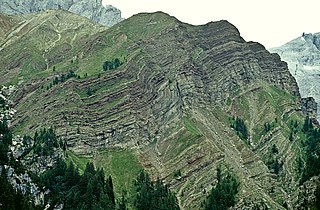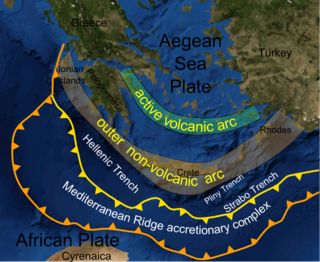Major tectonic units
Hyblean foreland

The foreland consists of exposures of the Hyblean Plateau and the offshore areas of Gela. The subduction forms a northward-dipping monocline in the foreland with a dip of 16–18°, which is a high angle compared to other regional monoclines. It is suggested that this steep angle is caused by a higher subductibility of the African slab. [6] Deformation in the foreland is dominated by normal faulting; most of these faults have been formed in the Neogene by plate flexure. Some of the faults are recognized to be much older, formed in the Mesozoic. The faults are suggested to have separated high-standing platforms from deeper basins. [8]
The simplified stratigraphy includes the following units: [6] [8]
| Age | Rock type | Formation environment | Thickness |
|---|---|---|---|
| Late Pliocene–Early Pleistocene [8] | Intermittent basalts [8] | ||
| Pliocene–Pleistocene [8] | Chalk/ calcarenite [8] | ||
| Jurassic–Late Miocene [6] | Limestone, w/ thick basalt interbedding [6] | Platform slope and open-shelf [6] | 1–2km [6] |
| Triassic–Early Jurassic [6] | Limestone/ carbonate turbidites [6] | Shallow-water sea [6] | 5–7km [6] |
The post-Paleogene geological events of the foreland can be divided into four main stages:
- At early Miocene, thrusting and volcanic activity triggered a regional uplift at the foreland, which caused the emergence of a broad carbonate platform in the eastern Hyblean Plateau. [9]
- During the Messinian of late Miocene, the Messinian salinity crisis occurred as a result of sea-level fall and major uplift, causing deposition of evaporites over the Mediterranean basin. The dry climate resulted in extensive erosion in high-standing regions of the plateau. [9]
- At Early Pliocene, rapid subsidence occurred at the foreland. This subsidence event occurred simultaneously with a major rise in Mediterranean sea level, during which Plio-Pleistocene sediments were accumulated in the foreland basin. [9]
- During the Late Miocene-Early Pleistocene, a massive basaltic volcanic activity occurred. After the emission of alkali basalts during the Late Miocene, major volcanic activity occurred during the Late Pliocene, in which large volumes of tholeiitic basalts were emitted and the foredeep north of the Hyblean foreland collapsed. [9]
Gela foredeep
The Gela foredeep extends from the northern margin of the Hyblean plateau on land to the offshore Gela basin of southwestern Sicily. Based on fossil analysis, the basin has been developing since Late Pliocene; its formation is related to the bending of the carbonate platform due to loading at the front of the Gela nappe. The basin fill consists of Late Miocene-Pleistocene sediments, including marly limestones, Messinian evaporites and sandy clays. [3]

The Apenninic-Maghrebian orogen
The central to western part of Sicily is made of the Maghrebian-Apenninic orogen and represents the fold and thrust belt of the subduction system. A combination of frontal accretion and low-angle detachments formed the present geological structure. [11] The orogen consists of a stack of detached nappes that involves mostly the Mesozoic carbonate, which has subsequently been folded into a syncline, underlying a broad anticline of the Caltanissetta area. [12]
The stratigraphy of the accretionary wedge is composed of the following units: [5] [6] [13]
| Stratigraphic unit | Age | Thickness | Rock type | Formation environment | Structures |
|---|---|---|---|---|---|
| Wedge-top deposits [6] | Upper Miocene–Pleistocene [6] | Marl/evaporites [6] | Shallow water/arid environment [6] | ||
| Sicilide unit [6] | Cretaceous–Early Tertiary [13] | 200–300m [13] | Carbonates [13] | Pelagic zone/sedimentary basin [13] | SW-&SE-vergent folds [6] |
| Numidian Flysch unit [6] | Upper Oligocene–Lower Miocene [5] | 1–1.5km [5] | Clays/quartzarenites [5] | Imbricate fans, SW-&SE-vergent folds [6] | |
| Imerese/Sicanian unit [6] | Permian-Cenozoic [6] | >1.5km [6] | Carbonates [6] | Deep water [6] | Antiformal stacks [6] |
| Transpanse–Saccense unit [6] | Meso-Cenozoic [6] | >5km [6] | Limestone [6] | Shallow water/pelagic zone [6] | Imbricate fans [6] |
| Hyblean unit [6] | Mesozoic [6] | 7–8km [6] | Limestone [6] | Shallow water/pelagic zone [6] | Imbricate fans, ached [6] |
Calabrian crystalline basement
The northeastern part of Sicily consists of the Calabrian Arc unit, the tectonic unit that connects the Apennines with the North African Maghrebide. Paleozoic igneous and metamorphic basement rocks are exposed at this part of the island, suggested to have been exposed by exhumation processes between mid-Oligocene and Middle Miocene. [14] The rapid migration of the Calabrian Arc towards the southeast was driven by the retreat of the Ionian slab east of Sicily. [1] In early Miocene, Calabria was still attached to Sardinia. In Middle Miocene, the trench rolled back to the east and normal faulting occurred between Calabria and Sardinia, causing Calabria to split eastward from Sardinia. By Early Pliocene, the retreat of Calabria consumed the oceanic slab of the Ionian sea while new oceanic crust was created in the Tyrrhenian Sea by back-arc magmatism. Since Pleistocene, the eastern portion of the arc formed the Apennine mountain of Italy, while the Calabrian block slid to Sicily through right lateral strike-slip motion, forming the northeastern portion of the island. [1] GPS measurements show that the Calabrian Arc still advances to the southeast at 2-3mm per year at present, due to the ongoing rollback of the Ionian slab. [15]
The simplified stratigraphy consists of the following units: [3]
| Age | Rock type |
|---|---|
| Early Pliocene | Chalk |
| Messinian | Evaporites |
| Middle Miocene-Messinian | Rift deposits/sandy marls |
| Paleogene-Middle Miocene | Arkosic Turbidites |
| Triassic-Late Cretaceous | Carbonate |
| Palaeozoic | Igneous/Metamorphic (basement) |



















